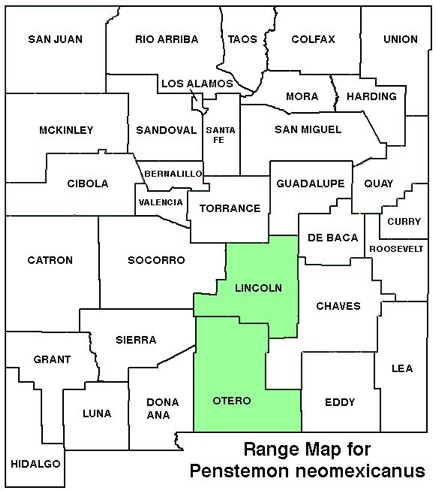WILDFLOWERS OF NEW MEXICO

Hairless stems stand 12–24 inches tall with an uncrowded spike with numerous tubular, blue to purple flowers. Note the flowers bloom on one side of the stem, and the opposite stem leaves are narrow and lance-shaped to linear. It occurs only in the Sacramento and Capitan mountains.
FLOWER: July–August. Flower a broadly inflated tube with blue, purple, or violet-blue lobes, 1–1 3/8 inches long (26-34 mm), and 3/8–3/4 inch wide (10-17 mm); the lower 3 lobes have long, white hairs. The beardtongue (staminode–infertile stamen) is hairless, white, and with a dilated tip which extends slightly beyond the throat.
LEAVES: Basal leaves usually wither by blooming; stem leaves opposite, sessile (no stems). Blades narrowly lance-shaped to linear, 1/4–5/8 inch wide (6–15 mm); margins entire, surfaces hairless.
HABITAT: Sandy, gravelly soils; wooded slopes, meadows; ponderosa pine, spruce-fir forests.
ELEVATION: 6,000–9,000 feet.
RANGE: NM.
SIMILAR SPECIES: The related Wand-bloom Penstemon, P. virgatus, with white, pink, or purple flowers, has no hairs, or only a few scattered hairs, on the flower’s lower lobes; it’s range extends from southern to northern NM and AZ.
NM COUNTIES: Locally common in southern NM in Sacramento and Capitan mountains in mid- to high-elevation, moist habitats: Lincoln, Otero.
NOTES: The larvae of the rare endemic Sacramento Mountains Checkerspot Butterfly, Occidryas anicia cloudcrofti, are apparently dependent on P. neomexicanus for food (NM Rare Plants).









NEW MEXICO PENSTEMON
PENSTEMON NEOMEXICANUS
Plantain Family, Plantaginaceae (formerly in Scrophulariaceae)
Perennial herb









THE CONTENTS OF THIS WEBSITE ARE COPYRIGHTED AND CANNOT BE USED
WITHOUT PERMISSION OF GEORGE OXFORD MILLER
















EMAIL ME






















































Flowers bloom on one side of the stem
-
•The lower lip is covered with long, white hairs (right arrow).
-
•The staminode is white, hairless, and slightly extends beyond the throat (left arrow).


Leaves are opposite, hairless, and narrowly linear to lance-shaped.









All photos Sacramento Mts.







